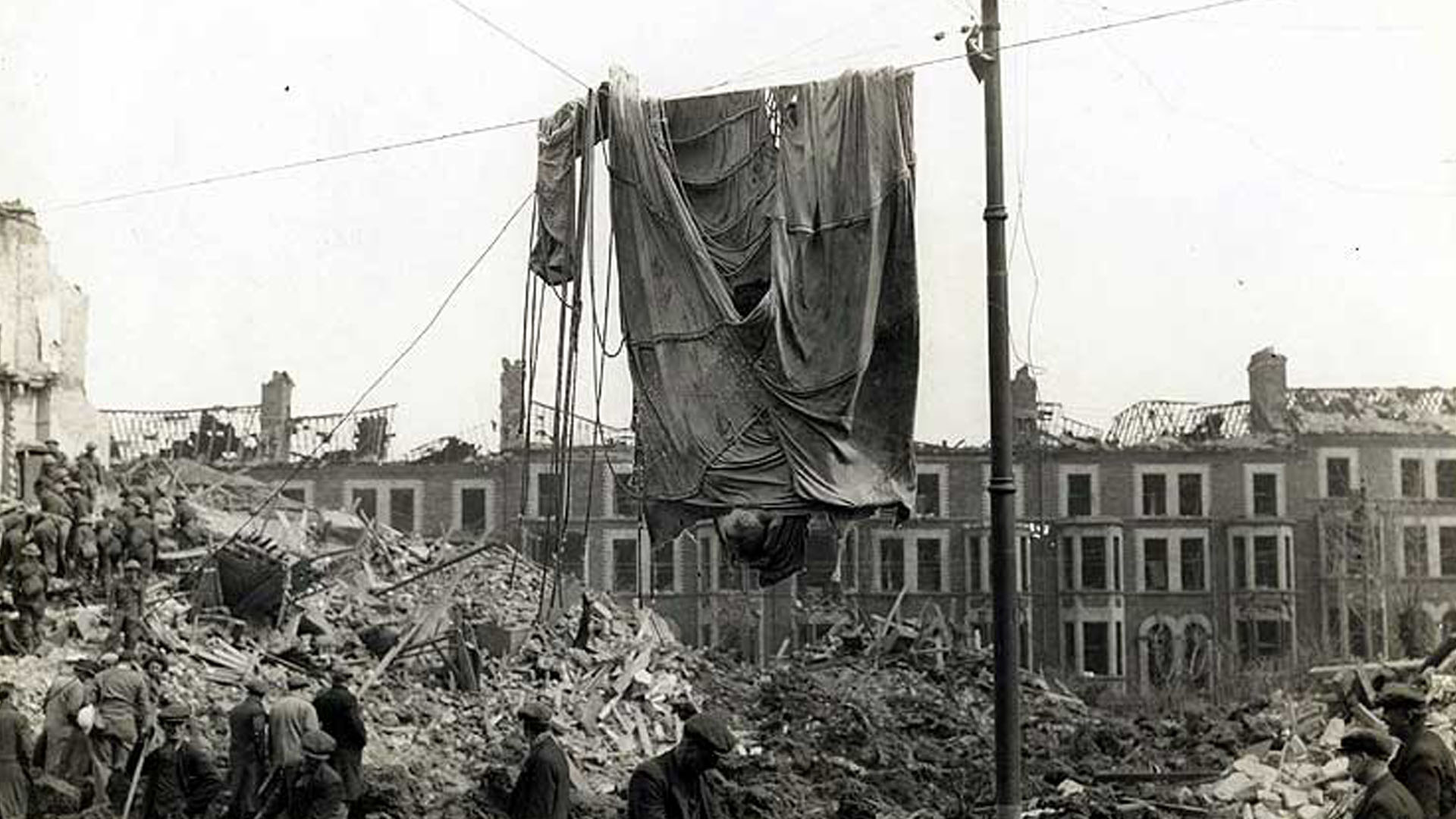Rifleman Stanley Burrows served in 2nd Battalion Royal Ulster Rifles during the Second World War. Born in Belfast, he attended Harding Memorial Primary School before taking on work in the shipyards. His father and uncles had served with distinction in the British Army and so, aged 18 years old in 1940, Stanley Burrows wanted to enlist.
He worked full-time in the shipyards and his father convinced bosses there to refuse Stanley permission to leave. Men working in the shipyard were important to the war effort as Harland and Wolff built many vessels for the Royal Navy.
Determined to enlist, Burrows got himself sacked from Harland and Wolff and joined 70th Battalion Royal Ulster Rifles. Intensive training began immediately. By 1941, when Stanley Burrows went to England with the Rifles, he had experienced the horrors of war.
The Luftwaffe bombed Belfast in what became known as the Belfast Blitz. As a young soldier with 70th Battalion, Burrows directed people to safety in Belfast’s Corporation Street. Later, he would find himself digging bodies from the rubble.
Dismissal From The Paras
Soon after moving to England, 70th Battalion disbanded. Burrows applied for the Commandos but his request came too late. He instead joined 6th Airborne Division. To gain Paratrooper wings, a soldier had to make eight flights. Stanley Burrows, however, would not get that far.
A second medical examination revealed that Burrows had had a perforated eardrum, which he had concealed. After six weeks with the paratroopers, his trick of drying out his seeping ear with peroxide had come undone. Many years later, after the death of his mother, Stanley learned she had tipped the authorities off.
From 6th Airborne Division, Stanley moved to 2nd Battalion Royal Ulster Rifles. Training began immediately. While some believed they were bound for Sicily, a move to Droxford, Hampshire saw them prepare for Normandy.
Stanley Burrows' D-Day
On D-Day, Burrows was part of 9th Platoon, ‘A’ Company, 2nd Battalion Royal Ulster Rifles. Bound for Sword Beach on a landing craft. Burrows was one of many soldiers who wrote one last letter home. Aged 22 years old, he addressed it to his mother in Belfast.
On 6th June 1944, a shell struck Stanley’s landing craft but failed to explode. From this vessel, Company Sergeant Major Walsh of ‘A’ Company and Rifleman Michael “Sticky” Ryan M.M. of ‘B’ Company formed a lifeline. This rope allowed men to pull themselves ashore.
Carrying 56lbs of equipment, “Bettsy” his Bren gun, and a fold-up bicycle, Burrows knew he would not make it to the beach. He threw the bicycle overboard and his D-Day began as shells and mortars fell around him. All of Burrows’ company made it ashore to the assembly point at Lion-sur-Mer deflecting sniper attacks all the way.
Taking Cambes Wood
On 7th June 1944, ‘A’ Company followed the lead of ‘D’ Company on a failed attack on the well-defended Cambes Wood. They would end the day retreating to Le Mesnil having avoided mortar fire, snipers, and four Luftwaffe planes.
On 9th June 1944, Stanley Burrows’ company again attacked Cambes Wood. Nine men from his platoon made it through the 10-foot wall into the woods. They fought through to a farmhouse taken by Lieutenant Corporal White. He requested a volunteer to return to Captain Montgomery to inform of their whereabouts. Burrows volunteered without hesitation. He returned through the woods, shouting for his own company to not shoot him and relayed the message before rejoining his platoon. For the next while, ‘A’ Company would make Cambes Wood their home.
On 19th June 1944, Stanley Burrows became an unlikely casualty at Cambes Wood. The Belfast man saw a chicken wandering through no-man’s land, sprang into action and within minutes the bird was in a soup. As Burrows cooked up the chicken broth in a biscuit tin, a shell landed nearby and boiling water covered him.
As he dived for cover, Burrows’ fellow soldiers realised he had caught fire and extinguished his burning clothes. He sought no treatment from medics and his body went into shock. His skin blistered and he learned he would have to return to England for treatment.
On the return to the United Kingdom, Stanley’s medical plane came under attack from the Royal Navy. Once again, he escaped unscathed. He would rejoin the Rifles that summer but after another injury on 9th August 1944, his service ended.
It was at Cambes Wood on 23rd June 1944, Stanley Burrows lost his best friend Hugh Crangles. A German sniper shot the 22-year old through the neck. The two men from Belfast, along with Robert Beck, made up the tight unit of Burrows, Beck, and Crangles – “The BBC”. Stanley would return many times to Normandy to pay tribute to Crangles and the other men of 2nd Battalion.
Remembering Stanley Burrows MBE
Burrows went on to serve with other units throughout the war including the paratroopers who liberated Copenhagen, Denmark. He demobbed in 1946.
Burrows observed the 60th anniversary of D-Day in Normandy with a group from Lisburn Royal British Legion. They spent five days there visiting the beaches, cemeteries, and memorials. Burrows carried a blackthorn walking stick and wore his green beret bearing the cap badge of the Royal Ulster Rifles. Next to him walked Richard Keegan who served in ‘D’ Company of the same battalion in 1944.
Rifleman Stanley Burrows MBE died on 2nd October 2004 after a short illness.
